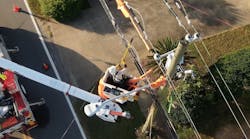Georgia Power Strengthens Reliability for Customers, Marks High Performance in 2023
Georgia Power continues to build the future of energy by making valuable investments in Georgia’s energy grid to make it stronger and more resilient for customers. Over the past 10 years, the company has invested more than $10 billion in strengthening the power grid through programs and initiatives approved by the Georgia Public Service Commission (PSC). Georgia Power continued this ongoing work on projects throughout Georgia communities in 2023 resulting in a strong year for reliability performance.
“At Georgia Power, we understand the importance of reliability for every customer and our teams share a commitment to work safely around the clock, and across the state, to deliver the power that our customers require,” said Tami Barron, senior vice president of Distribution for Georgia Power. “As we continue to upgrade our state’s power grid, we’re making purposeful investments using a data-driven approach, and increasingly incorporating automated technology that helps our electric system better respond not only during storms, but every day.”
Reliability is measured in two ways: frequency of service interruptions, or “System Average Interruption Frequency Index” (SAIFI), and duration of service interruption, or “System Average Interruption Duration Index” (SAIDI). Last year, Georgia Power’s SAIFI score was among the best in the company’s history, with customers experiencing an average of 15% fewer power outages than the previous year. Additionally, when customers did experience power outages, restoration times were approximately 27 minutes faster than the previous year. This duration measurement, or SAIDI value, was one of the best performances in recent years.
High service reliability in 2023 was driven, in large part, by the continued installation of smart, automated devices throughout the power grid. Last year alone, crews installed more than 1,000 automated devices across the state, which can be controlled remotely. This technology allows Georgia Power’s operations team to reroute power and segment a power line, which isolates issues and results in fewer customers affected by an outage, and faster restoration for others. Georgia Power is also deploying smart devices and other technology to enhance its self-healing network designed to respond to power outages automatically – saving valuable time and quickly getting the lights back on for customers. More than 60% of the company’s distribution grid can now be considered “self-healing,” helping avoid thousands of power outages each year.
In addition to installing smart technology, Georgia Power’s ongoing investments in the grid in recent years include: upgrading or rebuilding transmission lines and dozens of substations across Georgia for safe and reliable power delivery to homes and businesses; relocation of hundreds of miles of power lines underground, where it made the most impact; and improvement or installation of tens of thousands of power poles. All this infrastructure works together to improve reliability through a stronger and more resilient power grid and helped deliver last year’s high reliability.
“Georgia benefits from an integrated transmission system that includes nearly 20,000 miles of high-voltage power lines used by all of this state’s power companies to deliver energy from power generation sources to customers,” said Fran Forehand, senior vice president of Transmission for Georgia Power. “As our state continues to grow, we’re investing in this system to help keep reliability high for every Georgian year-round.”
Working in concert with the transmission and distribution network is Georgia Power’s diverse mix of generation resources, which also plays an essential role in providing reliable electric service to customers. In 2023, the company’s generation fleet helped keep reliability high with experienced teams at hydro, natural gas, nuclear and coal-fired generation plants managing plant operations and maintenance activities at a level of excellence well above industry standards. Non-nuclear generation assets measure reliability with plant outage rate or “equivalent forced outage rate” (EFOR). Last year, Georgia Power’s EFOR score was among the best in company history and among the best in the industry, with an outage rate of 1.49%. Georgia Power also continues to add renewable energy and battery energy storage to its generation mix, with reliability at the center of its planning process, and the company’s existing solar generation performing strongly as well in 2023.
“When extreme heat or cold, like we saw with Winter Storm Heather, drives increased demand for electricity, our Generation teams are at work 24/7 in Georgia’s power plants,” said Rick Anderson, senior vice president and production officer for Georgia Power. “We’re proud of the performance of our fleet last year and thank our team for their continued focus on reliability, as well as affordability by keeping production costs as low as possible for customers.”
Georgia Power continues to invest in a stronger and more resilient power grid through its successful multi-year Grid Investment Program, which has already resulted in an up to 50% improvement in reliability for some customers. As this work progresses, the company aims to deliver even more reliable energy for customers in the coming years.


